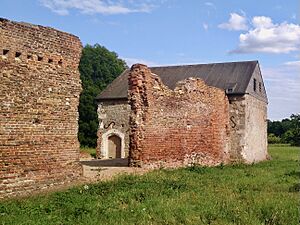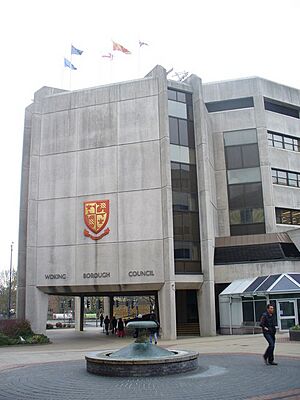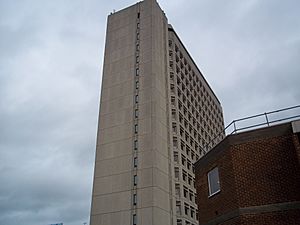History of Woking facts for kids
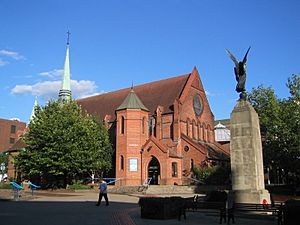
Woking is a town in Surrey, England. Its name means "settlement belonging to the followers of Wocc (or 'Wocca')". Over time, the name has been spelled in different ways, like Wochingas and Wokynge.
Contents
Woking's Early History
Ancient Times
On Horsell Common in Woking, you can find three ancient burial mounds called bell barrows. These mounds are about 3,000 to 4,000 years old! They might have been built to remember important leaders who moved to the area a long time ago. An old book from 1718, called 'A History of Surrey', mentions these mounds. Even though we know about them, there's no official record that they've ever been dug up by archaeologists.
The area where these mounds are located was probably farmland once, but because the soil wasn't very good for growing crops, it was used for burials instead. There might be more of these mounds hidden in the area, but so far, only three have been found.
Roman, Anglo-Saxon, and Norman Periods
Woking is mentioned in very old writings, some from the 12th century, that describe even earlier times. One of the earliest mentions is about a monastery (a place where monks live) in Wochingas around 708–715 AD. Later, in the 8th century, a king named Offa of Mercia gave special rights to this church. This meant the church of Woking was free from many normal taxes and rules, and only the abbot (leader of the monastery) had authority there.
It's thought that the church in Woking was first built about 1,300 years ago by monks from Chertsey. Sadly, Vikings probably destroyed this church around 1030–1060 AD. But it was rebuilt by 1066.
Woking also appears in the Domesday Book of 1086, which was a big survey of England ordered by William the Conqueror. In this book, Woking is called Wochinges and was divided into three different estates owned by the King, Walter FitzOther, and Osbern FitzOsbern.
There is also proof that Roman people lived in the area, specifically to the east of Old Woking.
Woking Palace
The first record of a building at the site of Woking Palace dates back to 1272. In 1466, Lady Margaret Beaufort, who was the mother of King Henry VII and grandmother of King Henry VIII, moved into the manor house there with her husband.
In 1490, an important agreement called the Treaty of Woking was signed at the Palace by King Henry VII. This agreement led to the marriage of Catherine of Aragon to Arthur, Prince of Wales. The modern Beaufort School in Goldsworth Park is named after Lady Margaret.
King Henry VII took the manor from his mother in 1503 and started to turn it into a palace. His son, King Henry VIII, continued this work and Woking Palace became one of his favourite places to stay.
By 1620, King James I gave Woking Palace to Sir Edward Zouch. Sir Edward then left the palace and built a new home nearby. After that, the palace buildings slowly fell apart, and the land around it was used for farming.
Today, you can visit the ruins of Woking Palace a few weekends each year. There are displays about how the Tudors lived, including Birds of Prey flying shows that teach about hunting with birds. You can also explore the gardens and fish ponds around the ruins. The River Wey runs along one side of the palace site, and a moat surrounds the rest of the nearly 8-acre area.
17th Century Developments
In 1651, the Wey Navigation Canal opened. This canal allowed boats to travel from Guildford through Woking to the River Thames. Later, in 1791, the Basingstoke Canal opened, connecting to the Wey Navigation Canal and reaching Horsell. The canal was fully opened to Pirbright in 1792.
In 1661, James Zouch was given permission to hold a market in Woking. He later became the Sheriff of Surrey from 1669 to 1670.
Woking in the 1800s
Modern Woking Begins
In 1849, people first suggested building a large cemetery for London, called the London Necropolis, in Woking. Later, in 1879, the Woking Crematorium was built in St John's. It was first used in 1884 for the first modern cremation in the UK.
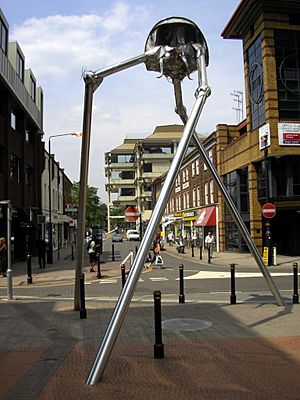
The famous writer H. G. Wells lived in Woking in 1898 and wrote his book The War of the Worlds there. Many parts of the story take place in Horsell, Woking, and the areas nearby. You can even see a sculpture of a Martian Tripod from his book in Woking!
New Buildings and Services
The 1850s saw the first new buildings in what would become 'New Woking', including the Albion Hotel. In 1862, the Royal Dramatic College opened in Maybury, but it closed in 1877. The Oriental Institute then opened on the same site in 1884, but it also closed in 1898.
In 1859, the Woking Convict Invalid Prison opened. This prison held sick prisoners. It closed in 1895.
The 1880s brought more new facilities to Woking. The Woking Police Station opened in 1887. In 1889, Woking Football Club was formed. That same year, the Woking Mosque opened. It was the first mosque built specifically for worship in Western Europe. Sultan Shah Jahan, Begum of Bhopal donated money to help build it, and it is now called the Shah Jahan Mosque in her honour.
The Victoria Hospital opened its doors in 1899. Woking also got electricity in 1890 and gas in 1891. By 1899, Woking had its own sewerage system.
Railways Arrive
The railways came to Woking in 1838 when the London and Southampton company (later called London and South Western Railway) opened its line. Woking Common Station, which is now Woking Station, opened at this time.
Local Government and News
In 1830, there was some civil unrest in Woking Parish. Later, in 1894, the Woking Local Board was formed to help manage the area. It had 18 councillors representing different parts of Woking. By 1895, the Woking Urban District Council was formed, taking over from the Local Board.
In 1894, the 'Woking News' newspaper was first published, costing 1d per copy. In 1895, the 'Woking Mail' started, costing 1⁄2d. These papers later joined together to become the 'Woking News and Mail'.
Woking: 1900–1945
Woking's Coat of Arms
In 1930, Woking Council was given a special symbol called a coat of arms by the College of Arms. This coat of arms is interesting because it uses parts from the symbols of past owners of the Woking Manor.
The cross in the middle is from Edward the Confessor. The red and gold colours come from the Bassett family's coat of arms, who owned the Manor after King John. The patterns called "frets" are from the Despenser family, who held Woking from 1281. And the "fleur-de-lis" symbols are from the Beaufort family's coat of arms, who owned the Manor in 1416.
Woking's motto is "Fide et Diligentia", which means "By Faith and Diligence".
Local Publications and Parks
In 1924, a free paper called 'Woking Offers' started, advertising local businesses. It was later renamed 'Woking Outlook' in 1928 and then 'Woking Review' in 1933. It's thought to be the oldest free newspaper in Britain!
Also in 1924, Waterer's Park was given to Woking Council by Anthony Waterer. Knaphill Football Club started playing there.
World War II Impact
During World War II, in 1945, a V-2 rocket launched by Germany landed on Woking.
Utilities and Facilities
In 1902, Woking's gas street lights were replaced with electric ones. Five years later, Horsell got its own sewerage system. During World War II, the Woking Fire Brigade was put under government control.
Around 1900, Woking's first outdoor swimming pool opened. By 1935, a second outdoor pool opened, and the Woking Swimming Club was formed that same year. In 1929, Woking Library opened its doors.
Transport Changes
In 1902, bus services started in the Guildford and Woking area. There was also a plan for a light railway between Woking and Bagshot, but this project didn't happen.
In 1915, the bus services were taken over by Aldershot and District Traction. In 1923, Southern Railway was formed and ran most of the train routes through Woking Station. During World War II, the Southern Railway was placed under government control.
Local Government Expands
In 1907, Horsell became part of the Woking Urban District Council. Then, in 1933, more areas like Byfleet, Pyrford, and parts of Woodham and Bisley were joined with Woking Urban District Council. By 1936, Woking's boundary was mostly the same as the current Woking Borough boundary.
Martinsyde Aircraft Company
The Martinsyde aircraft company started in 1908. In 1915, it moved its offices and aircraft manufacturing to Woking. By 1918, Martinsyde was Britain's third-largest aircraft maker! However, in 1920, a fire destroyed the factory, and aircraft production stopped. The company later closed down.
Woking After 1945
Town Twinning
Woking has "twin town" friendships with other towns around the world. In 1983, Woking became twinned with Amstelveen in the Netherlands. In 1992, it twinned with Le Plessis-Robinson in France. And in 1999, Woking twinned with Rastatt in Germany. These friendships help people from different countries learn about each other's cultures.
Big Local Employers
Many companies have had a presence in Woking. Kenwood, a company known for kitchen appliances, started in Woking in 1947 and had 700 workers before moving in 1961. James Walker Engineering also had a site in Old Woking from 1957 to 2006.
In 1963, the famous McLaren Racing Team was formed. They are well-known for their racing cars and even started building the new Mercedes SLR in 1999.
In 1976, British American Tobacco moved into Export House Tower, which is Woking's tallest building. Later, Telewest and then Virgin Media occupied the building.
Sports in Woking
Woking has a strong sports scene. In 1954, Woking Squash Club was formed. The Woking Archery Club was set up in 1968. Woking Football Club has been very successful, winning the FA Trophy in 1994, 1995, and 1997!
Town Planning and Growth
In 1965, a new plan for Woking predicted a population of 97,000 by 1981. This plan included building three new housing areas. One of these, known as 'Slococks', was built on former nursery lands.
In 1973, the government approved the plan to build a large housing estate called Goldsworth Park. Work started with plans for about 4,500 homes for around 15,000 people. The plan also included a lake, sports facilities, a golf course, shops, a swimming pool, a library, and other community buildings. The first residents moved into Goldsworth Park a year later.
New Facilities for the Community
In 1971, the Wolsey Place Shopping Centre opened. Around the same time, Centre Halls and Woking Centre Library also opened.
In 1973, a new covered swimming pool, called the Centre Pool, was opened. Later, in 1989, the Pool in the Park opened.
In 1983, the Woking Civic Offices were opened by the Duke of Gloucester.
The 1990s saw more big changes. In 1992, the Peacocks Shopping Centre, a new Library, the Town Gate, a Cinema, and the New Victoria Theatre all opened. The old Centre Halls, Centre Pool, and Woking Centre Library were taken down to make space for these new buildings. In 1996, The Planets Entertainment complex was finished. In 2010, a glass extension was added to the front of the Peacocks shopping centre.
In 1999, the Surrey History Centre officially opened. In 2007, work finished on a new canopy outside Woking Station.
Local Politics and Environment
In 1974, Woking Borough Council was formed. In 2006, Woking Borough Council announced a project to build 190 affordable homes.
On March 23, 2007, HRH Prince Charles opened a climate change exhibition at The Peacocks shopping centre. This exhibition taught people about important topics like recycling, saving energy, transport, reducing waste, and eating local food.
Telephone Codes
Between 1989 and 1994, Woking's telephone code changed from 04862 to 0483. Then, in 1994, Woking's phone code changed again to 01483, along with most other areas in the UK, on a day called Phoneday.
Transport Issues
On December 14, 1993, an explosion on the railway lines near Woking caused disruptions and closed nine stations in the area.
In 1996, South West Trains took over most of the train routes through Woking Station. In 2002, Arriva's bus depot in Woking closed and moved to Guildford.
Other Notable Events
In 1963, the famous band The Rolling Stones played a concert at the 'Atalanta' Ballroom in Woking.
Paul Weller, a well-known singer, was born in Sheerwater, Woking, on May 25, 1958. He later formed the band Jam in 1972.
Local Government in Woking
Woking Borough Council members are usually elected in parts, with about one-third of the members re-elected every year, serving four-year terms.
Party Control of Woking Borough Council
- 1974–1986: Conservative
- 1986–1992: No Overall Control (meaning no single party had a majority)
- 1992–1994: Conservative
- 1994–1996: No Overall Control
- 1996–1998: Liberal Democrats
- 1998–2007: No Overall Control
- 2007–2008: Conservative
- 2008–2011: No Overall Control
- 2011–2019: Conservative
- 2019–present: No Overall Control
Images for kids
-
A Bronze Age burial mound on Horsell Common
-
Sculpture of a Wellsian Martian Tripod near the Planets Entertainment centre, Woking.
See also
- List of Mayors of Woking
- Woking (UK Parliament constituency)
- Woking



